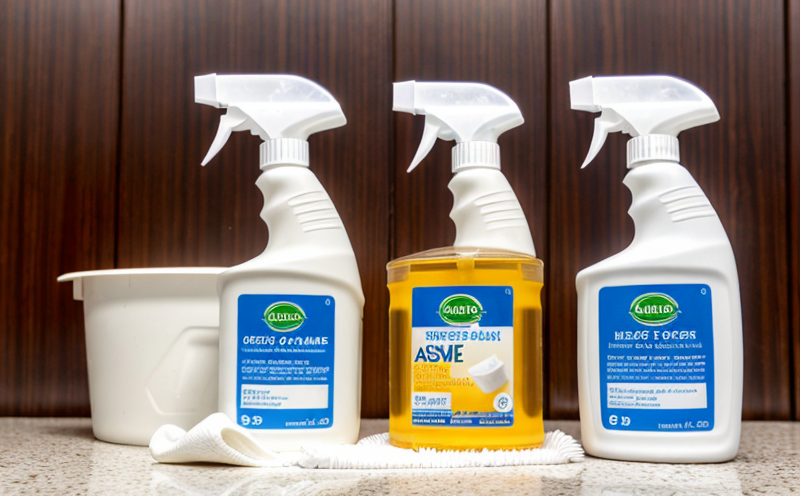ISO 14295 Cleaning Product Biodegradability Testing
The ISO 14295 standard is a cornerstone in the evaluation of cleaning product biodegradability, ensuring that products do not persist as pollutants after disposal. Compliance with this standard is essential for manufacturers aiming to meet environmental regulations and consumer expectations regarding sustainable practices.
Biodegradability testing under ISO 14295 involves subjecting samples of cleaning agents to controlled biological degradation processes in a laboratory setting. This process assesses the rate at which organic components break down naturally, reducing harmful environmental impacts post-disposal. The test typically employs inoculum derived from microorganisms commonly found in wastewater treatment plants.
The standard provides detailed guidance on selecting appropriate concentrations and volumes of cleaning products for testing based on their expected usage scenarios. This ensures that the biodegradability assessment reflects real-world conditions accurately. Specimen preparation involves diluting the product according to specified protocols, ensuring consistency across all samples being tested.
Testing methods outlined in ISO 14295 include both batch and continuous flow systems designed to mimic various environmental conditions. Results are quantified through measuring residual organic carbon levels at regular intervals throughout the degradation period. Compliance is determined by comparing these values against predefined thresholds specified within the standard.
Cleaning product developers must consider several factors when preparing for ISO 14295 compliance testing. These include understanding local regulations that may mandate specific biodegradability criteria, selecting appropriate analytical techniques suitable for detecting low levels of organic compounds remaining after degradation, and ensuring proper specimen preparation to avoid errors influencing results.
Compliance with ISO 14295 not only enhances a company's reputation but also opens up new markets where stringent environmental standards apply. By demonstrating commitment to sustainability through rigorous biodegradability testing, businesses can differentiate themselves from competitors and appeal more effectively to environmentally conscious consumers.
The importance of accurate specimen preparation cannot be overstated; even minor deviations in how samples are handled could lead to misleading results that do not reflect true biodegradation capabilities. Therefore, meticulous attention must be paid during sample collection, storage, and transport before analysis begins.
Understanding the broader implications of ISO 14295 goes beyond just technical aspects; it involves recognizing its role in fostering sustainable practices within industries reliant on chemical products for hygiene purposes. Through adherence to this standard, manufacturers contribute significantly towards reducing waste generation and promoting circular economy principles.
In conclusion, mastering ISO 14295 biodegradability testing is crucial for any company involved in producing or sourcing cleaning products. It offers a comprehensive framework ensuring that these essential items are environmentally friendly while maintaining their effectiveness in maintaining hygiene standards.
Applied Standards
The ISO 14295:2017 standard specifies the procedures for determining the biodegradability of cleaning products under defined conditions. This internationally recognized guideline ensures consistency and reliability across different laboratories performing these tests.
- Batch System: Suitable for testing low concentrations (≤3%) of active ingredients present in cleaning formulations.
- Continuous Flow System: Designed to evaluate higher concentration levels (>3%) typically found in concentrated solutions or concentrates intended dilution before use.
Both systems aim at simulating realistic wastewater conditions encountered during product lifecycle, thereby providing a robust basis for assessing biodegradability performance accurately. Compliance with these standards helps ensure that cleaning products perform effectively while minimizing potential negative environmental impacts upon disposal.
Quality and Reliability Assurance
Ensuring accurate and reliable ISO 14295 compliance testing requires stringent quality control measures at every stage of specimen preparation, inoculation, incubation, and measurement. Rigorous calibration procedures for analytical instruments used in quantifying residual organic carbon are crucial to prevent errors that could compromise test results.
Laboratories specializing in this service employ skilled personnel trained extensively on handling sensitive materials safely and efficiently while adhering strictly to prescribed protocols throughout each step of the process. This expertise guarantees consistent outcomes regardless of variations in input factors such as temperature, pH levels, or initial microbial populations.
Regular audits conducted internally help maintain high standards by identifying areas needing improvement continuously. External reviews performed periodically by independent bodies further reinforce trustworthiness and credibility among stakeholders involved directly or indirectly with cleaning product development cycles.
The commitment to quality extends beyond laboratory operations into supply chain management, ensuring that only reputable suppliers are engaged in procuring necessary raw materials used during specimen preparation stages. By fostering such practices, companies uphold their reputation for delivering trustworthy results consistently.
Environmental and Sustainability Contributions
Adherence to ISO 14295 plays a pivotal role in advancing environmental sustainability initiatives across industries dependent on chemical products for hygiene purposes. By promoting cleaner manufacturing processes, it contributes significantly towards reducing overall carbon footprints associated with production cycles.
- Reduction of Landfill Waste: Encourages recycling and reusing components instead of disposing them improperly into landfills, thus extending resource lifecycles sustainably.
- Better Resource Utilization: Fosters efficient use of raw materials by optimizing formulation compositions during product development stages, leading to less wastage throughout supply chains.
Furthermore, compliance with ISO 14295 fosters innovation within R&D departments focused on creating greener alternatives for existing products. Such efforts contribute positively towards meeting global commitments made under frameworks like the Paris Agreement aimed at combating climate change effectively.





